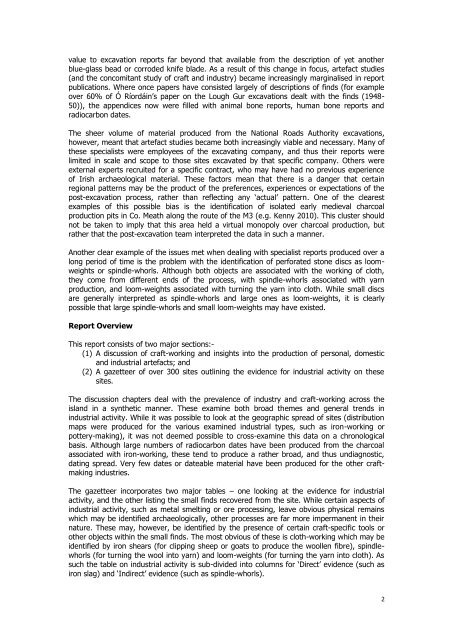EMAP_2012_Report_6_1.pdf (7.3 MB) - The Heritage Council
EMAP_2012_Report_6_1.pdf (7.3 MB) - The Heritage Council
EMAP_2012_Report_6_1.pdf (7.3 MB) - The Heritage Council
You also want an ePaper? Increase the reach of your titles
YUMPU automatically turns print PDFs into web optimized ePapers that Google loves.
value to excavation reports far beyond that available from the description of yet another<br />
blue-glass bead or corroded knife blade. As a result of this change in focus, artefact studies<br />
(and the concomitant study of craft and industry) became increasingly marginalised in report<br />
publications. Where once papers have consisted largely of descriptions of finds (for example<br />
over 60% of Ó Ríordáin’s paper on the Lough Gur excavations dealt with the finds (1948-<br />
50)), the appendices now were filled with animal bone reports, human bone reports and<br />
radiocarbon dates.<br />
<strong>The</strong> sheer volume of material produced from the National Roads Authority excavations,<br />
however, meant that artefact studies became both increasingly viable and necessary. Many of<br />
these specialists were employees of the excavating company, and thus their reports were<br />
limited in scale and scope to those sites excavated by that specific company. Others were<br />
external experts recruited for a specific contract, who may have had no previous experience<br />
of Irish archaeological material. <strong>The</strong>se factors mean that there is a danger that certain<br />
regional patterns may be the product of the preferences, experiences or expectations of the<br />
post-excavation process, rather than reflecting any ‘actual’ pattern. One of the clearest<br />
examples of this possible bias is the identification of isolated early medieval charcoal<br />
production pits in Co. Meath along the route of the M3 (e.g. Kenny 2010). This cluster should<br />
not be taken to imply that this area held a virtual monopoly over charcoal production, but<br />
rather that the post-excavation team interpreted the data in such a manner.<br />
Another clear example of the issues met when dealing with specialist reports produced over a<br />
long period of time is the problem with the identification of perforated stone discs as loomweights<br />
or spindle-whorls. Although both objects are associated with the working of cloth,<br />
they come from different ends of the process, with spindle-whorls associated with yarn<br />
production, and loom-weights associated with turning the yarn into cloth. While small discs<br />
are generally interpreted as spindle-whorls and large ones as loom-weights, it is clearly<br />
possible that large spindle-whorls and small loom-weights may have existed.<br />
<strong>Report</strong> Overview<br />
This report consists of two major sections:-<br />
(1) A discussion of craft-working and insights into the production of personal, domestic<br />
and industrial artefacts; and<br />
(2) A gazetteer of over 300 sites outlining the evidence for industrial activity on these<br />
sites.<br />
<strong>The</strong> discussion chapters deal with the prevalence of industry and craft-working across the<br />
island in a synthetic manner. <strong>The</strong>se examine both broad themes and general trends in<br />
industrial activity. While it was possible to look at the geographic spread of sites (distribution<br />
maps were produced for the various examined industrial types, such as iron-working or<br />
pottery-making), it was not deemed possible to cross-examine this data on a chronological<br />
basis. Although large numbers of radiocarbon dates have been produced from the charcoal<br />
associated with iron-working, these tend to produce a rather broad, and thus undiagnostic,<br />
dating spread. Very few dates or dateable material have been produced for the other craftmaking<br />
industries.<br />
<strong>The</strong> gazetteer incorporates two major tables – one looking at the evidence for industrial<br />
activity, and the other listing the small finds recovered from the site. While certain aspects of<br />
industrial activity, such as metal smelting or ore processing, leave obvious physical remains<br />
which may be identified archaeologically, other processes are far more impermanent in their<br />
nature. <strong>The</strong>se may, however, be identified by the presence of certain craft-specific tools or<br />
other objects within the small finds. <strong>The</strong> most obvious of these is cloth-working which may be<br />
identified by iron shears (for clipping sheep or goats to produce the woollen fibre), spindlewhorls<br />
(for turning the wool into yarn) and loom-weights (for turning the yarn into cloth). As<br />
such the table on industrial activity is sub-divided into columns for ‘Direct’ evidence (such as<br />
iron slag) and ‘Indirect’ evidence (such as spindle-whorls).<br />
2
















